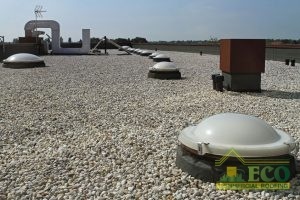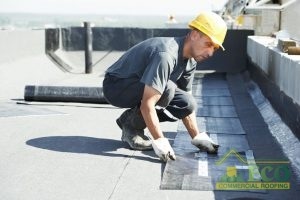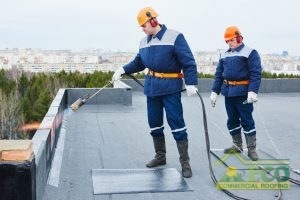
Flat Roofs Come In Different Materials To Help You Get The Most Out Of Your Roof.
Flat roofs are a hot commodity with commercial buildings but they are also starting to make an appearance on the residential roofing stage. If you are building your new home and are trying to decide which type of roofing system would be best for you, it is worth taking the time to consider the benefits of owning a flat roof.
Types of Flat Roofing
There are several different flat roofing materials that you can choose from. Each of the different types provides their own unique protection for your home or business are suited for different types of environments. No matter what type of flat roof type you go with, the one thing they all have in common is that they are easy to repair.
Here is a rundown of the different flat roofing types.
Bur Roofs
Bur roofs, also known as build-up roofs, have been a popular fat roofing style in the United States for 100 years. They have an unmistakable tar mixed with gravel look which is used to help reflect UV light from the sun, avoiding sun damage to the roof.
Bur roofs have come a long way from their original conception, as they are now paired with insulation to help make them more energy efficient. Today, they are made with layers of bitumen, ply sheets, and gravel or stones to give the roof its reflective property.
The lifespan of a bur roof is comparable to that of an asphalt roof, (which makes sense because the primary material of bitumen is asphalt,) which is about 15-30 years. Proper installation along with regular maintenance can help your roof last til 40 years, but it all depends on you as the homeowner.
Bur roofs last better in warmer climates, as colder climates could cause expansion and contraction of the asphalt. This leads to cracks which can lead to leaks.
Modified Bitumen Roofing
Modified Bitumen roofing, like bur roofs, has asphalt as its primary component. What makes bitumen roofing stand out among the other roofing types is its durability. This is due to the fact that the seams of a bitumen roof are melted together during installation, which completely erases them. Without seams, the modified bitumen roofing is practically leak-proof, which is great for areas that experience a lot of rainfall.
Modified bitumen roofs also are highly resistant to wind, fire, and impact damage. This makes them perfect for environments that experience severe weather often, allowing them to better protect your home and business. This is because the material doesn’t give in to pressure as easily as other roofing styles. Because of their durability, they have a long warranty and a minimum lifespan of 20 years.
EPDM Rubber Roof
EPDM give home and business owners a more environmentally friendly option to flat roofing. Made primarily out of rubber (duh), the roof is mostly made out of recycled materials, helping to reduce the amount of waste in landfills and saving up on natural resources.
This type of roof is also great for your wallet, as they are able to reflect heat away from your homeowner business, allowing you to save on your energy bill. During the winter, you won’t have to worry about being cold either, as the rubber acts as an insulator, keeping the heat inside your home or business and not escaping outside.
EPDM rubber roofs are also highly durable and boast a lifespan of 30-50 years. Unlike other flat roofing types which struggle with the build-up of water since it doesn’t have anywhere to go, rubber roofs expel water causing it to run off the roof or to quickly become evaporated once the sun comes back out. This helps in the prevention of leaks, which is one of the leading cause of roofs not reaching the end of their lifespan. They are also wind resistant, as the material stretches out and adheres to your roof. Fire is also not a problem, as rubber is naturally a flame retardant.
Spray Polyurethane Roof
Spray Polyurethane Roofs are one of the easiest types of flat roofing to install, and because so, has a lower installation cost. In fact, this type of roofing can be applied over pre-existing roofs as well, making them a favorite among homeowners and business owners. This is because the material is installed by a spray (hence the name), and then foams to create the actual roof. This allows spray polyurethane roofs to be extremely versatile, fitting to virtually any roof type.
The spray and foam technique also allows this flat roofing type to be seamless, allowing it to highly leak resistant as water has a hard time getting underneath the roof. Without the seams, it also produces a roof that is able to keep hot air in during the winter and reflect the UV light from the sun during the summer, keeping your home nice and insulated, which helps cut back on your energy bills.
The one thing to keep in mind about spray polyurethane roofs is that they do not fare well against impact damage, making them less than ideal for areas that experience a lot of hail.
Thermoplastic Membranes

Flat Roofs Are Easy To Maintain And Repair.
Thermoplastic membrane roofing takes the best of EPDM rubber roofing and builds upon it, making for a hardier longer lasting roof. As one of the newer materials on the roofing market, the thermoplastic membrane is a mixture of talc, fiberglass, carbon fiber, wollastonite, and metal oxysulfate.
It is one of the cheaper flat roofing options, which is making it more and more popular with home and business owners. It also helps that this particular type of roofing easily fits in with any home style and the beautiful white color of it eye-catching which helps to raise curb-appeal.
As with EPDM rubber roofing, thermoplastic membranes are extremely durable having both UV reflective properties and a water-resistant surface. The water resistant and UV reflective properties help the roof be a deterrent for mold and fungus growth, as the materials fail to provide these pests an optimal place to grow.
Unlike EPDM rubber roofing, thermoplastic membranes are impact resistant, making them more of an ideal match for those looking for a flat roof that can handle severe storms that produce hail or toss around debris.
Flat Roofing Compared To Other Roofing Types
Compared to other roofing types, such as a pitched roof, flat roofs have their pros and cons that sets them apart from their competitors. A flat roof is one of the more economically and environmentally friendly of the roofing types. Which, with more and more people concerned about both their finances and the environment, this type of roofing serves as a solution to both. They also are easy to repair from damages and most of them have reflective properties which makes them resistant to sun damage.
This being said, they usually are not the best when it comes to areas that experience a lot of rainfall, as the flatness of the roof gives water nowhere to go except to pool up. If the roof does not have some kind of relief from the water than it gets to the point where leaks begin to occur, which is one of the biggest problems facing flat roofs. Also, most of them do not have a very high impact resistance, which is not good for areas that experience severe storms.
Contact Us

Call Us Today To Get More Information On Flat Roof Installation And Repair.
The type of roofing that is best for you depends on the kind of area you are living and what it is that you are looking to gain from your roof. If you need help deciding which type of roof would be best for you, or you need a flat roof repair in New Orleans, LA then call the expert team of roofers at ECO Commercial Roofing at 877-406-7663.
Another Commonly Asked Question?
- Does A Flat Roof Need Gutters?
- Yes. Gutters need to be pitched in order to allow the water on the roof to safely make its way back to the ground, which can help the roof avoid leaks.


